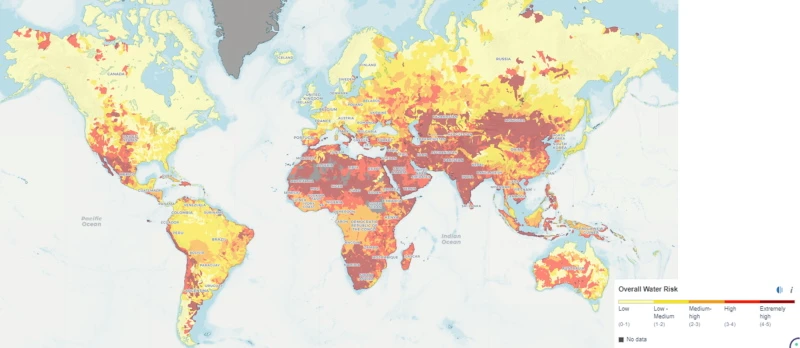Water stress, a global concern
Essential for life on Earth, water faces an existential challenge with the distressing decline of numerous freshwater basins worldwide. Water stress increasingly poses a risk to the stability of our planet, as it can cause water-dependent ecosystems to collapse. As such, freshwater scarcity is listed in the top five long-term risks in the last edition of the World Economic Forum Global Risk Report.1 Its ramifications extend across multiple facets of sustainable development, including human hygiene, food security, and involuntary migration.
Water consumption is also reflected in the Planetary Boundaries Framework.2 The nine planetary boundaries, which include land system change, biochemical flows, and novel entities, are key biophysical processes that regulate the resilience and stability of our planet. Recent research reveals that the freshwater change boundary, together with five other boundaries, have now been transgressed,3 meaning our planet is in a ‘zone of increasing risk’. This stresses how important it is to adequately address this issue in our SDG Framework.
“
Recent research reveals that the freshwater change boundary, together with five other boundaries, have now been transgressed, meaning our planet is in a ‘zone of increasing risk’
Data limitations
The Aqueduct Water Risk Atlas spotlights the regions around the globe that are grappling with acute water stress. In these places, the extraction of water exerts disproportionate pressure on already fragile ecosystems. Ideally, we would adopt a science-based approach and systematically assess companies’ volumes of water consumption against the regeneration rates of local watersheds. Such a lens can help avoid demand and supply imbalances. However, this requires spatially explicit data on water consumption along the value chains of thousands of companies, which is unfortunately not available. Instead, we have to take a global approach, although we can still take into account local context when assessing water stress.
Figure 1: Water stress around the globe

Source: Aqueduct Water Risk Atlas4
Qual è il punteggio di sostenibilità di aziende e paesi?
Scopri il contributo delle aziende agli Obiettivi di Sviluppo Sostenibile e la classifica dei paesi in base ai criteri ESG.
How we assess company impact on water scarcity
In consonance with the philosophy of our SDG Framework, we want to capture significant impacts that issuers have on water scarcity. Therefore, our assessment focuses on companies with substantial operations in regions experiencing high levels of water stress. In addition, we only include companies that operate in ‘critical impact sectors’ as defined by the Carbon Disclosure Project.5
Next, we opt for a forward-looking approach that assesses whether the trends in these companies’ water footprint are in line with a trajectory that brings us back within ‘safe operating spaces’ by 2030, the deadline of the SDG agenda. A recent technical report stressed that we are currently transgressing the planetary threshold for blue water, found in lakes, rivers and reservoirs, with a staggering 161–414 km3 per annum.6 In line with the precautionary principle, we aim for a reduction of 414 km3 of blue water consumption by 2030 to return to operating within the planetary threshold, which scientist have set at 4,000 km3.7 In order to achieve this goal, the world has to reduce its water consumption by 1.417% per year until 2030.
“
We want to capture significant impacts that issuers have on water scarcity.
Thus, companies whose water consumption declines by >1.417% per year on average can reasonably be perceived as adhering to a global pathway that is in harmony with the SDGs. Conversely, companies that are not reducing, and even in some cases increasing their water consumption, impede the SDGs. In addition, to avoid assigning positive/negative SDG scores to companies that currently have a high/low water footprint, we set thresholds on existing levels of water consumption. We assign positive and negative scores on SDGs 6 and 15 if companies meet the two criteria listed in Table 1 below.
Table 1: Water consumption and SDG scores

Source: Robeco 2023
As a result, around 20% of the companies in scope for the assessment receive a negative score. In line with the Pareto Principle, this group is accountable for roughly 80% of total water consumption by all companies in scope.
The data used in the assessment reflects companies’ direct water use that occurs in their own operations, as well as indirect freshwater use associated with business practices upstream in the supply chain. This way, vertically integrated companies are not unduly punished for high water footprints compared to those that have outsourced water-intensive activities to suppliers. For instance, food production is often highly water-intensive, though this is typically not reflected in the water use of downstream food producers, as the majority of water consumption occurs during upstream agricultural production.
“
We opt for a forward-looking approach that assesses whether the trends in these companies’ water footprint are in line with a trajectory that brings us back within ‘safe operating spaces’ by 2030
Next steps: Water discharge
Whereas water consumption volumes affect the quantity of available freshwater, discharge of untreated water can influence the quality of natural freshwater sources. Due to the lack of company disclosure on discharge water quality, for the time being our focus is on water consumption. However, we actively monitor new sources of information to improve our understanding of the impacts on water quality.
Scopri gli ultimi approfondimenti iscrivendoti alla nostra newsletter mensile
Ricevete la nostra newsletter Robeco e siate i primi a leggere gli ultimi approfondimenti.
Footnotes
1 https://www3.weforum.org/docs/WEF_Global_Risks_Report_2023.pdf
2 https://www.stockholmresilience.org/research/planetary-boundaries.html
3 https://www.science.org/doi/10.1126/sciadv.adh2458
4 https://www.wri.org/applications/aqueduct/water-risk-atlas/#/
5 https://www.cdp.net/en/investor/water-watch-cdp-water-impact-index
6 Grafton, R. Q., Krishnaswamy, J., & Revi, A. (2023). TECHNICAL REPORT-The Water Cycle and the Economy-March 2023.
7 https://www.science.org/doi/10.1126/science.1259855


